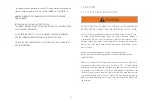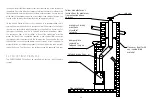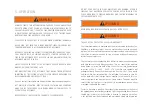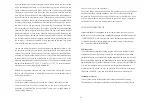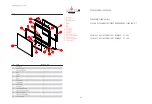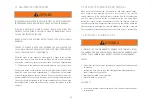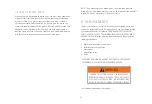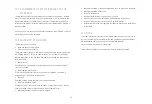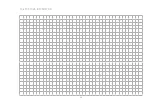
45
6.1 FIRE EXTINGUISHERS / SMOKE DETECTORS
All homes with a solid fuel burning appliance should have at least one fire
extinguisher in a central location, known to all, and at least one smoke
detector in the room containing the appliance. If it sounds an alarm, cor-
rect the cause but do not de-activate or relocate the smoke detector.
6.2 FUEL
WARNING
THIS APPLIANCE IS DESIGNED TO BURN NATURAL WOOD ONLY. DO NOT
BURN TREATED WOOD, COAL, CHARCOAL, COLOURED PAPER, CARDBOARD,
SOLVENTS OR GARBAGE. THIS APPLIANCE HAS NOT BEEN TESTED WITH
AN UNVENTED GAS LOG SET. TO REDUCE RISK OF FIRE OR INJURY, DO NOT
INSTALL AN UNVENTED GAS LOG SET INTO THE APPLIANCE.
HIGHER EFFICIENCIES AND LOWER EMISSIONS GENERALLY RESULT
WHEN BURNING AIR DRIED SEASONED HARDWOODS, AS COMPARED TO
SOFTWOODS OR TOO GREEN OR FRESHLY CUT HARDWOODS. DO NOT
BURN GREEN OR FRESHLY CUT WOOD.
BURNING WET UNSEASONED WOOD CAN CAUSE EXCESSIVE CREOSOTE
ACCUMULATION. WHEN IGNITED IT CAN CAUSE A CHIMNEY FIRE THAT MAY
RESULT IN A SERIOUS HOUSE FIRE.
DO NOT STORE FUEL WITHIN THE CLEARANCE TO COMBUSTIBLES, OR IN
THE SPACE REQUIRED FOR RE-FUELING AND ASH REMOVAL.
When loading the appliance, ensure that the upper fibre baffles are not
forced out of position. For maximum efficiency, when the appliance is
throughly hot, load it fully to the line of air inlet nozzles at the backside
of the firebox or, if not present, to 50% of the fireboxes backside height
and burn at a medium low setting. The whiteness of the bricks and the
cleanliness of the glass are good indicators of your operating efficiency.
Not enough heat is produced when only a few pieces of wood are burned
or the wood may not burn completely. Fuel for the appliance must not be
stored closer than the required clearances to combustibles (heat sensitive
material).
NEVER STORE WOOD IN THE ASH PAN COMPARTMENT (IF APPLICABLE).
NOTE: WHEN LOADING THE APPLIANCE, ENSURE TO KEEP FUEL BACK
FROM THE GLASS. IF COALS ARE TO ACCUMULATE ON THE FRONT LIP,
THERE IS A CHANCE THEY WILL FALL OUT WHEN THE DOOR IS OPENED.
Burn only dry, clean unpainted wood that has been seasoned. It produces
more heat and less soot or creosote. Freshly cut wood contains about
50% moisture while after proper seasoning only about 20% of the water
remains. As wood is burned, this water boils off consuming energy that
should be used in heating. The wetter the wood, the less heat is given off
and the more creosote is produced. Dry firewood has cracks in the end of
the grain. Both hardwood and softwood burn equally well in this appliance
but hardwood is denser, will weigh more per cord and burn a little slower
and longer.
Summary of Contents for M 700 INSERT
Page 40: ...40...
Page 56: ...56 10 6 FOR YOUR INFORMATION...
Page 57: ...57 10 6 FOR YOUR INFORMATION...
Page 58: ...58 10 6 FOR YOUR INFORMATION...





